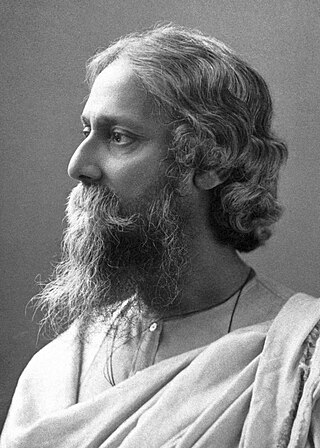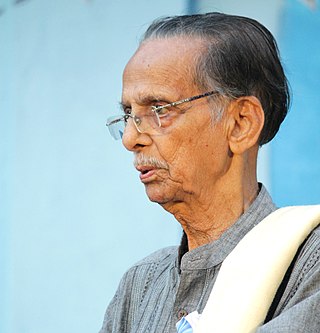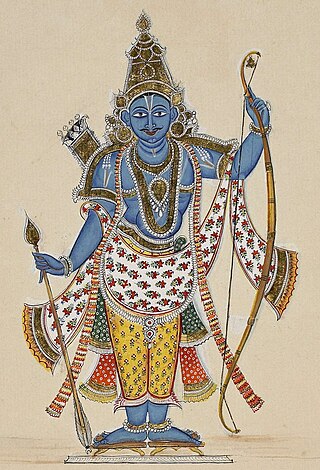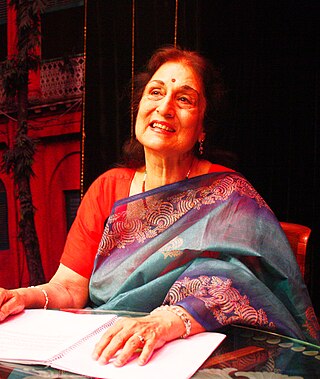
The Ramayana is a Sanskrit epic from ancient India, one of the two important epics of Hinduism, the other being the Mahābhārata. Together, they form the core of Hindu religious history. The epic, traditionally ascribed to the Maharishi Valmiki, narrates the life of Rama, a prince of Ayodhya in the kingdom of Kosala. The epic follows his fourteen-year exile to the forest urged by his father King Dasharatha, on the request of Rama's stepmother Kaikeyi; his travels across forests in the Indian subcontinent with his wife Sita and brother Lakshmana; the kidnapping of Sita by Ravana, the king of Lanka, that resulted in war; and Rama's eventual return to Ayodhya along with Sita to be crowned king amidst jubilation and celebration.

Okakura Kakuzō, also known as Okakura Tenshin(岡倉 天心), was a Japanese scholar and art critic who in the era of Meiji Restoration reform defended traditional forms, customs and beliefs. Outside Japan, he is chiefly renowned for The Book of Tea: A Japanese Harmony of Art, Culture, and the Simple Life (1906). Written in English, and in the wake of the Russo-Japanese War, it decried Western caricaturing of the Japanese, and of Asians more generally, and expressed the fear that Japan gained respect only to the extent that it adopted the barbarities of Western militarism.

Dance in India comprises numerous styles of dances, generally classified as classical or folk. As with other aspects of Indian culture, different forms of dances originated in different parts of India, developed according to the local traditions and also imbibed elements from other parts of the country.

Utpal Dutt was an Indian actor, director, and writer-playwright. He was primarily an actor in Bengali theatre, where he became a pioneering figure in Modern Indian theatre, when he founded the "Little Theatre Group" in 1949. This group enacted many English, Shakespearean and Brecht plays, in a period now known as the "Epic theatre" period, before it immersed itself completely in highly political and radical theatre. His plays became an apt vehicle for the expression of his Marxist ideologies, visible in socio-political plays such as Kallol (1965), Manusher Adhikar, Louha Manob (1964), Tiner Toloar and Maha-Bidroha. He also acted in over 100 Bengali and Hindi films in a career spanning 40 years, and remains most known for his roles in films such as Mrinal Sen’s Bhuvan Shome (1969), Satyajit Ray’s Agantuk (1991), Gautam Ghose’s Padma Nadir Majhi (1993) and Hrishikesh Mukherjee's breezy Hindi comedies such as Gol Maal (1979) and Rang Birangi (1983). He also did the role of a sculptor, Sir Digindra Narayan, in the episode Seemant Heera of Byomkesh Bakshi on Doordarshan in 1993, shortly before his death.

Bengali literature denotes the body of writings in the Bengali language and which covers Old Bengali, Middle- Bengali and Modern Bengali with the changes through the passage of time and dynastic patronization or non-patronization. Bengali has developed over the course of roughly 1,300 years. If the emergence of the Bengali literature supposes to date back to roughly 650 AD, the development of Bengali literature claims to have 1,600 years of old. The earliest extant work in Bengali literature is the Charyapada, a collection of Buddhist mystic songs in Old Bengali dating back to the 10th and 11th centuries. The timeline of Bengali literature is divided into three periods: ancient (650–1200), medieval (1200–1800) and modern. Medieval Bengali literature consists of various poetic genres, including Hindu religious scriptures, Islamic epics, Vaishnava texts, translations of Arabic, Persian and Sanskrit texts, and secular texts by Muslim poets. Novels were introduced in the mid-19th century. Nobel laureate Rabindranath Tagore is the best known figure of Bengali literature to the world. Kazi Nazrul Islam, notable for his activism and anti-British literature, was described as the Rebel Poet and is now recognised as the National poet of Bangladesh.

Komal Kothari (1929-2004) was an Indian folklorist and ethnomusicologist. Komal Kothari had devoted his life to investigation and documentation of folk traditions of western Rajasthan. Kothari received the honour of Padma Shri and Padma Bhushan from the Government of India. Komal Kothari painstakingly worked to preserve the cultural memory and made numerous recordings of folk music. He studied Langa and Manganiyar communities of folk musicians of Thar desert. Komal Kothari was not only a scholar but also a man of action. He co-founded Rupayan Sansthan - Rajasthan Institute of Folklore, in 1960 in the village of Borunda. The institution houses a repository of recordings by Kothari and works to collect, preserve, and disseminate the oral traditions of Rajasthan. Kothari was co-editor of the journal Lok Sanskriti, a journal based on the theme of folk culture. Besides, Kothari arranged international performances of folk artists from Rajasthan in several counries. His monograph on Langas, a folk-musician caste in Rajasthan, was enlivened by an accompanying album of recordings of twelve folk songs sung by Langa artistes. His understanding of desert culture and its connections with ecology endeared him to the environmentalists. He planned a museum based on the ecology of the broom’, to show the technical use of specific types of desert grass for specific purposes. His vision was actualised in the form of Arna Jharna - The Thar Desert Museum of Rajasthan in Borunda, near Jodhpur.Kothari was a scholar of patterns of culture and his expertise enriched both folklore studies and history.

Kavalam Narayana Panicker was an Indian dramatist, theatre director, and poet. He has written over 26 Malayalam plays, many adapted from classical Sanskrit drama and Shakespeare, notably Kalidasa's Vikramorvasiyam, Shakuntalam (1982), Bhasa's Madhyamavyayogam (1979), Karnabharam, Uru Bhangam (1988), Swapnavasavadattam, and Dootavakyam (1996). He was the founder – director of theatre troupe, Sopanam, which led to the foundation of Bhashabharati: Centre for Performing Arts, Training and Research, in Trivandrum.

Theatre of India is one of the most ancient forms of theatre and it features a detailed textual, sculptural, and dramatic effects which emerged in mid first millennium BC. Like in the areas of music and dance, the Indian theatre is also defined by the dramatic performance based on the concept of Nritya, which is a Sanskrit word for drama but encompasses dramatic narrative, virtuosic dance, and music. Historically, Indian theatre has exerted influence beyond its borders, reaching ancient China and other countries in the Far East.

Ramlila is any dramatic folk re-enactment of the life of Rama according to the ancient Hindu epic Ramayana or secondary literature based on it such as the Ramcharitmanas. It particularly refers to the thousands of the Hindu god Rama-related dramatic plays and dance events, that are staged during the annual autumn festival of Navaratri in India. After the enactment of the legendary war between good and evil, the Ramlila celebrations climax in the Vijayadashami (Dussehra) night festivities where the giant grotesque effigies of evil such as of the rakshasa (demon) Ravana are burnt, typically with fireworks.

Sudhindra Sircar, also known as Badal Sarkar, was an influential Indian dramatist and theatre director, most known for his anti-establishment plays during the Naxalite movement in the 1970s and taking theatre out of the proscenium and into public arena, when he transformed his own theatre company, Shatabdi as a third theatre group. He wrote more than fifty plays of which Ebong Indrajit, Basi Khabar, and Saari Raat are well known literary pieces. A pioneering figure in street theatre as well as in experimental and contemporary Bengali theatre with his egalitarian "Third Theatre", he prolifically wrote scripts for his Aanganmanch performances, and remains one of the most translated Indian playwrights. Though his early comedies were popular, it was his angst-ridden Evam Indrajit that became a landmark play in Indian theatre. Today, his rise as a prominent playwright in 1960s is seen as the coming of age of Modern Indian playwriting in Bengali, just as Vijay Tendulkar did it in Marathi, Mohan Rakesh in Hindi, and Girish Karnad in Kannada.
Kṛttivāsī Rāmāyaṇ,; also called Śrīrām Pãcālī, composed by the fifteenth-century Bengali poet Krittibas Ojha, from whom it takes its name, is a rendition of the Rāmāyaṇa into Bengali. Written in the traditional Rāmāyaṇa Pā̃cālī form of Middle Bengali literature, the Kṛttivāsī Rāmāyaṇ is not just a rewording of the original Indian epic, but also a vivid reflection of the society and culture of Bengal across the period of its circulation, from the Middle Ages into the modern period. It was characterised by Dinesh Chandra Sen in 1911 as 'by far the most popular book in Bengal' and 'the Bible of the people of the Gangetic Valley'.
Julie B. Mehta teaches at University College, University of Toronto. Her course, Asian Cultures in Canada, is endowed by Chancellor Emerita Senator Vivienne Poy. Mehta is an author and journalist specializing in Southeast Asia.

Rama is a major deity in Hinduism. He is the seventh and one of the most popular avatars of Vishnu. In Rama-centric traditions of Hinduism, he is considered the Supreme Being.

John Emigh is Professor Emeritus from the Departments of Theatre, Speech and Dance and of English at Brown University, Providence, Rhode Island. Emigh taught at Brown from 1967 to 2009. Since his retirement, he has mainly been teaching and directing in the Brown/Trinity Rep MFA program.

Chhipi is a caste of people with ancestral roots tracing back to India. They are found in the states of Gujarat, Rajasthan, Madhya Pradesh, Haryana, Delhi, Uttar Pradesh of India. Chhipa are also found in Pakistan.

Vinay Lal is a historian of India. He is Professor of History and Asian American Studies at UCLA. He writes widely on the history and culture of colonial and modern India, popular and public culture in India, cinema, historiography, the politics of world history, the Indian diaspora, global politics, contemporary American politics, the life and thought of Mohandas Gandhi, Hinduism, and the politics of knowledge systems. He is known for his radical political views and for making his history lectures available for free on his YouTube channel.

Rabana Chhaya is a form of shadow puppetry from the eastern Indian state of Odisha.

Jalabala Vaidya was an Indian stage actress. She was best known for her one-woman performance of The Ramayana which is her husband, Gopal Sharman's contemporary dramatic interpretation of the Sanskrit epic. This Ramayana, subtitled 'the epic; as a play in English' is the only Indian production to this day to have played on Broadway. Jalabala Vaidya, Gopal Sharman and their daughter Anasuya Vaidya, are the founders and directors of The Akshara Theatre – non-profit arts institution in New Delhi, India.
Natya Vidya Mandir, a theatre school, and its amateur theatre troupe Natmandal from Ahmedabad, Gujarat, India had heavily influenced new Gujarati theatre. Established in 1949, it trained many theatre people and produced classic, modern and experimental plays in its twenty years of existence.
Paula Richman is an Emerita William H. Danforth Professor of South Asian Religions at Oberlin College. She is an expert in the Tamil language and has edited a series of books about the Ramayana, including Many Ramayanas, Questioning Ramayana, Ramayana Stories in Modern South India and Performing the Ramayana Tradition.
















